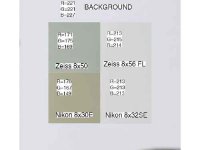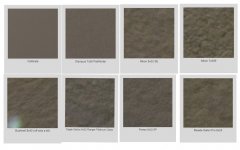Ronh; ...I bet Photo shop or a similar program could be used to analyze these images quantitatively, for transmission vs color, and overall vision-weighted transmission.
The problem is that you only get three points on the spectrum (RGB) as this isn't a spectrometer it's a camera.
The other issue is knowing exactly where and how wide these three "receptors" (color bands) are. I would presume they would have to be fairly close to the average human positions (so the colors map) but being colorblind (RG deutroanomalous ... so my green receptor color max is shifted to the red) I know how this things can differ.
That will vary from camera to camera so you have a problem with comparing different results from different users.
As a technique as Henry has presented it (for comparisons between bins with the same camera) it is an interesting technique. We just have to send bins to Henry to get them done

It seems to me that ronh makes a valid point with regard to analyzing the color content of the pixelated photos. This is different from analyzing the light emerging from the instrument's exit pupil, which would require a spectrometer. But, if one is going to make such digital recordings in the first place, it's probably a good basis for making an objective comparison; rather than relying on individual color perceptions that are influenced by biological factors, color contrast, and the color bias of the monitor.
Using Adobe ImageReady for a quick evaluation, the RGB color mix of each panel is shown in the attachment. Weightings vary somewhat over each area, but the main result is clear. (I'm too lazy to take an average of several readings, so I picked the center.) The background is slightly weighted towards blue, and brighter than any of the four panels. The average of the three RGB background values is 223, suggesting that exposure was 223/255 = 87.45% of maximum, — since on this scale pure white = 255 and pure black = 0.
On individual panels, the Zeiss 8x50 image is biased green-red, the Nikon E image is biased red-green, the Zeiss FL image is almost neutral but slightly green, and the SE image is neutral. These results represent the binoculars' filtering of the blue-biased background image.
By expressing the average of the three RGB values as a percentage of the average background value (i.e., 223), the transmission efficiency of the four binoculars can be estimated as:
Zeiss 8x50 = 172/223 = 77.1%
Nikon 8x30 = 162/223 = 72.6%
Zeiss 8x56 = 214/223 = 96.0%
Nikon 8x32 = 213/223 = 95.5%
This seems more or less reasonable to me. The reliability of the procedure can be determined by others doing the same thing with their Adobe or similar software.
Ed






